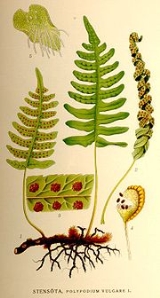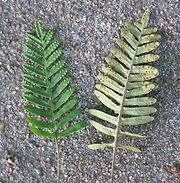
Polypodium vulgare
Encyclopedia
Polypodium vulgare, the common polypody, is a fern of the Polypodiaceae
family.
 Polypodium vulgare, the common polypody, is a fern developing in isolation from along a horizontal rhizome
Polypodium vulgare, the common polypody, is a fern developing in isolation from along a horizontal rhizome
. The fronds with triangular leaflets measure 10 to 50 centimetres. They are divided all the way back to the central stem in 10 to 18 pairs of segments or leaflets.
The leaflets become much shorter at the end of the frond. The leaflets are generally whole or slightly denticulated and somewhat wider at their base, where they often touch each other. They have an alternating arrangement, those on one side being slightly offset from those on the other side. The petiole
s have no scales.
The sori
are found on the lower side of the fronds and range in colour from bright yellow to orange. They became dark grey at maturity.
, where it is found up to an altitude of 2000 metres (6,561.7 ft). It is also quite common in Scandinavia
and Carpathian Mountains
. It is present but less commonly found around the Mediterranean region.
In the United States
it is commonly found in the Pacific Northwest
(especially Oregon and Washington) from coastal areas inland, and throughout the Cascade Range
. In California
the subspecies Polypodium vulgare var. columbianum (synonym: Polypodium hesperium - Maxon) is found in the higher Sierra Nevada and eastern Transverse Ranges
.
It is an introduced species
in New Zealand
, that has begun to spread into the wild as an invasive species
.
Polypodiaceae
Polypodiaceae is a family of polypod ferns, which includes more than 60 genera divided into several tribes and containing around 1,000 species. Nearly all are epiphytes, but some are terrestrial.-Description:...
family.
Description

Rhizome
In botany and dendrology, a rhizome is a characteristically horizontal stem of a plant that is usually found underground, often sending out roots and shoots from its nodes...
. The fronds with triangular leaflets measure 10 to 50 centimetres. They are divided all the way back to the central stem in 10 to 18 pairs of segments or leaflets.
The leaflets become much shorter at the end of the frond. The leaflets are generally whole or slightly denticulated and somewhat wider at their base, where they often touch each other. They have an alternating arrangement, those on one side being slightly offset from those on the other side. The petiole
Petiole (botany)
In botany, the petiole is the stalk attaching the leaf blade to the stem. The petiole usually has the same internal structure as the stem. Outgrowths appearing on each side of the petiole are called stipules. Leaves lacking a petiole are called sessile, or clasping when they partly surround the...
s have no scales.
The sori
Sorus
A sorus is a cluster of sporangia .In fungi and lichens, the sorus is surrounded by an external layer. In some red algae it may take the form of a depression into the thallus....
are found on the lower side of the fronds and range in colour from bright yellow to orange. They became dark grey at maturity.
- Period of sporulation: July to September.
- Mode of dissemination: anemochory (wind dispersal).
Geographical distribution
The common polypody is very common in FranceFrance
The French Republic , The French Republic , The French Republic , (commonly known as France , is a unitary semi-presidential republic in Western Europe with several overseas territories and islands located on other continents and in the Indian, Pacific, and Atlantic oceans. Metropolitan France...
, where it is found up to an altitude of 2000 metres (6,561.7 ft). It is also quite common in Scandinavia
Scandinavia
Scandinavia is a cultural, historical and ethno-linguistic region in northern Europe that includes the three kingdoms of Denmark, Norway and Sweden, characterized by their common ethno-cultural heritage and language. Modern Norway and Sweden proper are situated on the Scandinavian Peninsula,...
and Carpathian Mountains
Carpathian Mountains
The Carpathian Mountains or Carpathians are a range of mountains forming an arc roughly long across Central and Eastern Europe, making them the second-longest mountain range in Europe...
. It is present but less commonly found around the Mediterranean region.
In the United States
United States
The United States of America is a federal constitutional republic comprising fifty states and a federal district...
it is commonly found in the Pacific Northwest
Pacific Northwest
The Pacific Northwest is a region in northwestern North America, bounded by the Pacific Ocean to the west and, loosely, by the Rocky Mountains on the east. Definitions of the region vary and there is no commonly agreed upon boundary, even among Pacific Northwesterners. A common concept of the...
(especially Oregon and Washington) from coastal areas inland, and throughout the Cascade Range
Cascade Range
The Cascade Range is a major mountain range of western North America, extending from southern British Columbia through Washington and Oregon to Northern California. It includes both non-volcanic mountains, such as the North Cascades, and the notable volcanoes known as the High Cascades...
. In California
California
California is a state located on the West Coast of the United States. It is by far the most populous U.S. state, and the third-largest by land area...
the subspecies Polypodium vulgare var. columbianum (synonym: Polypodium hesperium - Maxon) is found in the higher Sierra Nevada and eastern Transverse Ranges
Transverse Ranges
The Transverse Ranges are a group of mountain ranges of southern California, in the Pacific Coast Ranges physiographic region that runs along the Pacific coast from Alaska to Mexico in North America. The Transverse Ranges begin at the southern end of the California Coast Ranges and lie between...
.
It is an introduced species
Introduced species
An introduced species — or neozoon, alien, exotic, non-indigenous, or non-native species, or simply an introduction, is a species living outside its indigenous or native distributional range, and has arrived in an ecosystem or plant community by human activity, either deliberate or accidental...
in New Zealand
New Zealand
New Zealand is an island country in the south-western Pacific Ocean comprising two main landmasses and numerous smaller islands. The country is situated some east of Australia across the Tasman Sea, and roughly south of the Pacific island nations of New Caledonia, Fiji, and Tonga...
, that has begun to spread into the wild as an invasive species
Invasive species
"Invasive species", or invasive exotics, is a nomenclature term and categorization phrase used for flora and fauna, and for specific restoration-preservation processes in native habitats, with several definitions....
.
Habitat
This fern is found in shaded and semi-shaded locations. It is found on old walls, cracks in rocks, the bases of trees and in rocky undergrowth. It prefers sandy soils and rarely tolerates lime.Uses
- In cooking: The rhizome has a bittersweet taste. It has traditionally been used in some confectionery such as nougatNougatNougat is a variety of similar traditional confectioneries made with sugar and/or honey, roasted nuts , and sometimes chopped candied fruit. The consistency of nougat can range from soft and chewy to hard and crunchy depending on its composition, and it is used in a variety of candy bars and...
for its aromatic properties. In 1971, a saponinSaponinSaponins are a class of chemical compounds, one of many secondary metabolites found in natural sources, with saponins found in particular abundance in various plant species...
, osladinOsladinOsladine is a naturally occurring, high-intensity sweetener isolated from the rhizome of Polypodium vulgare. It is a saponin, sapogenin steroid glycoside, 500 times sweeter than sucrose....
was found in the roots and believed to be the compound responsible for the sweet taste as it elicits a relative sweetness 500 times sweeter than sugarSucroseSucrose is the organic compound commonly known as table sugar and sometimes called saccharose. A white, odorless, crystalline powder with a sweet taste, it is best known for its role in human nutrition. The molecule is a disaccharide composed of glucose and fructose with the molecular formula...
(by weight). - Medicinal: The dried rhizome has been used in traditional medicineTraditional medicineTraditional medicine comprises unscientific knowledge systems that developed over generations within various societies before the era of modern medicine...
as a purgative and vermifuge due to it containing phytoecdysteroidPhytoecdysteroidPhytoecdysteroids are plant derived ecdysteroids. Phytoecdysteroids are a class of chemicals that plants synthesize for defense against phytophagous insects. These compounds are exact replicas of hormones used by the arthropod and crustacean families in the molting process known as ecdysis...
s.
Note
- The name Polypodium vulgare is sometimes applied to the Polypodium virginianumPolypodium virginianumPolypodium virginianum, commonly known as Rock Polypody, Rock Cap Fern, or Common Polypody, is a small evergreen species of fern native to the Eastern United States and Canada...
(rock polypody). Licorice fern is also known as Polypodium glycyrrhiza.

